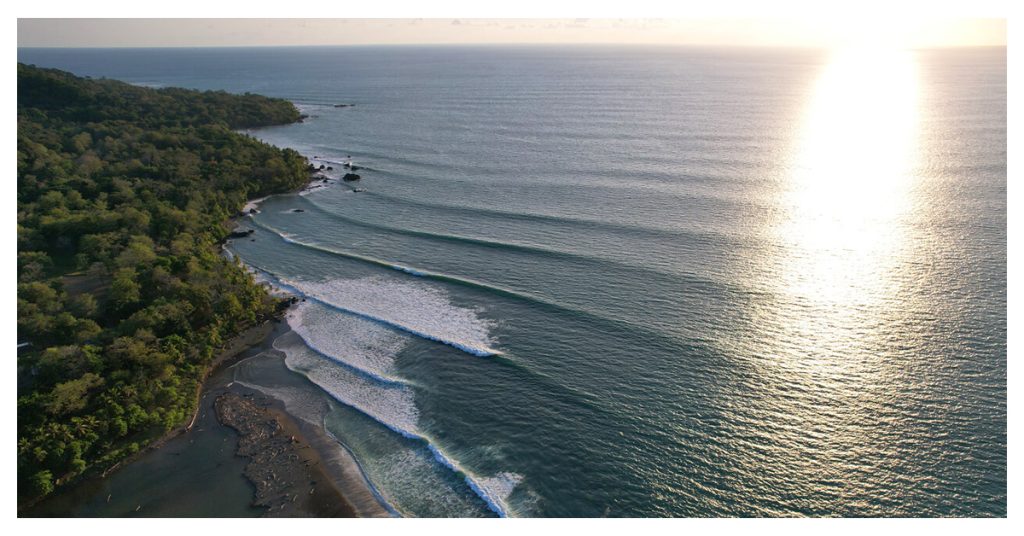Costa Rica is a surfer’s paradise with its perfect mix of beginner-friendly waves and expert breaks. This exotic Central American destination offers world-class waves year-round along with stunning beaches, lush jungles, and a laidback pura vida lifestyle. Here’s my guide on where to catch the best waves and everything you need to know for the best surfing in Costa Rica.
The Best Spots for Surfing in Costa Rica
With 1,300 km of coastline, there are countless excellent surf spots dotting both the Pacific and Caribbean coasts. Some prime destinations for surfing in Costa Rica for beginners include:
1. Playa Guiones

Part of the popular beach town of Nosara, this is a 3-mile stretch of excellent surf for all levels. Gentle, consistent waves make it a top choice for beginners. Besides, this is the best place for surfing in Costa Rica in December.
2. Pavones

Home to one of the world’s longest left-hand point breaks that can run for over a kilometer down the shore when conditions are right. If you are an experienced surfer and looking for an iconic spot for surfing in Costa Rica in October, then head to this “Pavones” surfing spot.
3. Playa Hermosa

Just south of Jacó, this beach lives up to its name with fun peaks and hollow barrels for intermediate to advanced surfers. Witch’s Rock – An epic right-hand point break only accessible by boat near the Osa Peninsula. Witch’s Rock churns out huge, powerful waves for experts.
4. Playa Grande

With multiple peaks, this spot north of Tamarindo produces reliable waves for surfers of all skill levels year-round. This place is ideal for surfing in Costa Rica in November.
Read More – Top 8 Virginia Beach Attractions to Plan Your October Adventure
Best Season to Go Surfing in Costa Rica
As a tropical destination, you can find great waves in Costa Rica during every season:
December to March – The dry season has offshore winds grooming the waves beautifully, especially on the Northern Pacific coast.
April to August – Though the green season brings occasional rain showers, it also produces smaller crowds and consistent waves.
September to November – With ideal weather, crowdless beaches, and wave heights picking up, autumn is a prime time for surf trips.
Surfing in Costa Rica For Beginners
For those looking to learn how to surf, Costa Rica is the perfect place to catch your first waves. Gentle beach breaks like Playa Guiones and Jacó are ideal for beginner surf lessons. Many surf camps like Safari Surf School offer week-long packages with daily lessons, board rentals, accommodations, and tours included.
Don’t get discouraged if you don’t stand up on the board right away. Take your time to get comfortable paddling out past the breakers, popping up, and balancing. With warm water and sandy beaches, Costa Rica’s beginner surf spots let you progress at your own pace.
What to Wear Surfing in Costa Rica?
You’ll want to wear a basic surfing wetsuit (2-3mm thickness) year-round for protection from the sun and any reefs or rocks. Water temperatures average in the mid-80s Fahrenheit so a full wetsuit isn’t necessary unless you easily get cold.
Rash guard shirts, board shorts, surf trunks, bikinis, and one-piece swimsuits are also popular. Apply liberal amounts of waterproof SPF30 (or higher) sunscreen when surfing in Costa Rica and wear sunglasses to protect your eyes. Bring sandals and water shoes for walking out over rocky bottoms and sea urchins.
Surfing Etiquette and Safety Tips
Before paddling out at those enticing Costa Rican waves, be sure to brush up on surf etiquette and safety:
- Avoid “snaking” waves by waiting your turn for a wave and letting the surfer closest to the peak take off first.
- Be patient and don’t aggressively try to steal waves from better surfers, especially locals who know the break best.
- If you wipe out, cover your head with your arms, and don’t try to stand up in shallow water.
- Don’t surf beyond your limits in huge waves or dangerous conditions. Beginners should stick to smaller waves in their comfort zone.
- Watch out for riptides that can quickly pull you away from shore. If caught in one, don’t fight it directly – swim parallel to shore until you’re out of the current.
FAQs
1. Where is the best surfing in Costa Rica?
Some of the most famous surf spots are Pavones for its epic long left break, Playa Guiones for beginner waves, Playa Hermosa and Santa Teresa for intermediate/advanced waves, and Witch’s Rock for huge, expert-only barrels.
2. Where to go surfing in Costa Rica?
Beginners should start at beaches with mellow waves like Playa Guiones, Jacó, Playa Herradura, Playa Tamarindo, or Playa Dominical. Take lessons from a surf camp or school for the best learning experience.
3. What to wear surfing in Costa Rica?
Wear a 2-3mm wetsuit year-round for sun/reef protection, plus a rash guard shirt, boardshorts/bikini, water shoes, and high SPF sunscreen. The water is warm (80s F) so a full wetsuit usually isn’t needed.
4. When is the best time to travel for surfing in Costa Rica?
September to November are ideal months for surfing in Costa Rica with minimal rain, smaller crowds, offshore winds, and wave heights building. December-March brings perfect weather in the dry season but more tourists.
5. Does Costa Rica have good surfing?
Yes, Costa Rica is considered one of the world’s premier surf destinations. With abundant beach breaks, point breaks, and reef waves, it offers amazing surf for all levels year-round along both its Pacific and Caribbean coasts.


